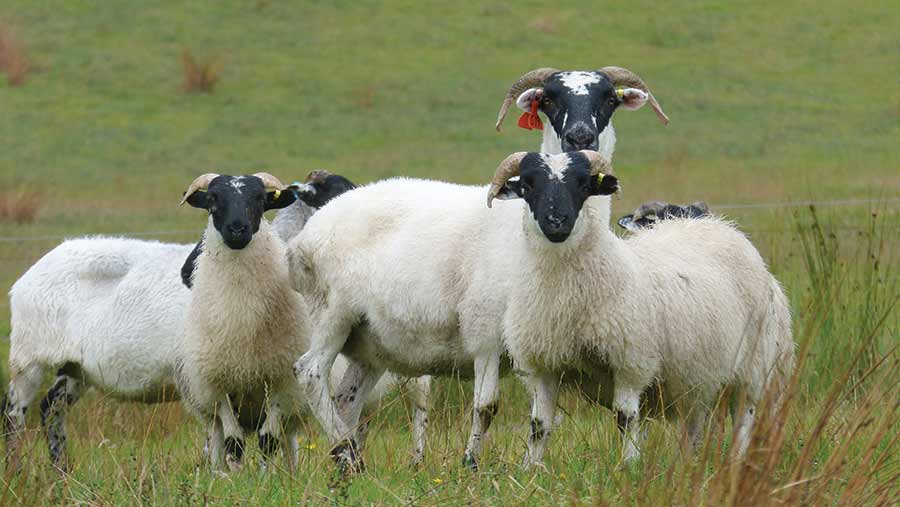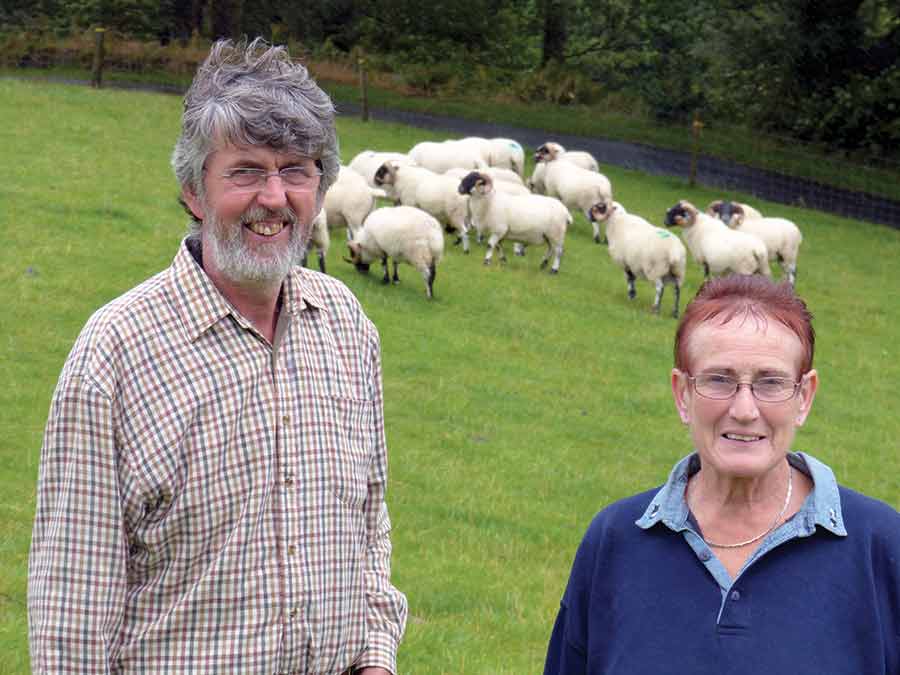Performance recording helps lift lamb cheque by £9k/year
A commercial Scottish Blackface flock is turning a corner on maternal ability after making quick gains on carcass weights, tagging more than 100% for the first time by performance recording.
Bobby Lennox tagged one of two hill flocks at 103% (110% scanning) this spring, expecting his flock to wean about 95% on Shemore Farm, one of two stretches of hill he farms on the Luss Estate, Loch Lomond.

© Michael Priestley/RBI
The hill farm on the other side of the glen – Shantron – is on course to rear 86% (109% scanning). Meanwhile, 100 or so lambs are expected to be gathered in October on Shemore, potentially taking the weaned total higher.
See also: Debate: Is performance recording hill breeds a waste of time?
Shantron Farm facts
- 1,620ha in total
- 80ha of good in-bye grazing
- 240ha of hill park
- 40ha of improved hill parks limed in 1970s and regularly sprayed for bracken
- 1,500 Scottish Blackface ewes (1,100 commercial ewes and 400 recorded ewes)
- 20 blue grey and Saler-cross-type cows put to Charolais bull
- Lambs sold fat via Highland Glen grading at >85% R-grade or better
- Breeding tups now sold annually
This is on top of other genetic improvements achieved since starting to record the flock through Signet in 1989.
Gains are worth £14 a lamb, according to estimates by independent consultant Rhidian Jones of RJ Livestock Systems, which at 700 lambs a year is worth £9,800.
Furthermore, half a condition score on ewes at tupping allows a more fertile flock to be tupped in a 21-day period as opposed to 34 days.
Maternal traits
The farm’s once below-average maternal ability index peaked at 1.19 last year, ahead of the breed average of 1.08.
But Mr Lennox stresses that maternal gains have proved harder to achieve than terminal gains.
“For heavier lambs I looked at eight-week weight and scan weight to make sure I was breeding for heavier carcasses,” explains Mr Lennox.
“We were seeing heavier carcasses after four or five years. I would put a tup rated high for muscle depth on ewes that needed help.”
Maternal ability then became a more important feature and was focused on in 2009, becoming one of three key attributes (along with eight-week weight and muscle depth).
“The only change was to start placing more emphasis on selecting the tups rated high for the maternal ability trait – ideally without compromising on muscle depth and eight-week weight – while keeping an eye on muscle depth and eight-week weaning weight,” says Mr Lennox.
“I continued to ignore mature size and litter size, as I’m happy with my sheep’s size and litter numbers.”
Improving maternal ability |
|||||||
|
Year |
2010 |
2011 |
2012 |
2013 |
2014 |
2015 |
2016 |
|
Shantron Farm maternal ability index |
0.77 |
0.69 |
0.75 |
0.91 |
1.01 |
1.19 |
1.15 |
|
Breed average |
0.76 |
0.84 |
0.9 |
0.95 |
0.93 |
1.01 |
1.08 |
Maternal sheep group
Back in 1989, Bobby and wife Anne started “doing their own thing” with regards to recording their flock and how they weighted EBVs to produce an index of their own to benchmark stock.

Bobby and Anne Lennox © Michael Priestly/RBI
They selected for milkier mothers and culled out underperformers, whether for health or maternal reasons.
At the first strike ewes are cross-bred to a Meatlinc tup, but a second strike sees them culled out of the flock.
“Anything with mastitis or a prolapse is a cull ewe, as is not rearing a lamb. Lame sheep get a notch, persistently lame sheep get a second notch and are culled. Every year is notched on the tag in a different place, so there are no paper records needed.”
In 1993, four Scottish farms, including Shantron, formed the Blackface Sire Reference Group. This changed to the Maternal Sheep Group to include other maternal breeds. The next step was to borrow ideas from the Welsh Camda index and through work with the SRUC, the Hill 2 index was eventually developed.
Also benchmarking sheep of the North Country Cheviot breed, the Hill 2 index is designed to enhance ewe productivity by improving several traits.
Signet advises farmers that ewe mature weight, maternal ability, longevity and number of lambs reared to weaning will increase if the index is used to choose female replacements.
Mr Lennox explains: “The index weights the traits we measure economically to give a pound value. As breeders we don’t see this value, but that’s how they work it out.
“Weights and data are the same in performance recording, but it’s how the traits are weighted to create an index that matter in the end. At one time there was a lot of weighting of lambs born, for example, and I didn’t want this as I was having enough lambs born.”
Benefits of Hill 2 index
No buckets or licks are used through the winter or spring. Thin sheep (2.25 body condition score), twins and any triplets are fed a ewe pellet at lambing at a maximum rate of 0.3kg a ewe twice a day.
Fit singles lamb on the hill, although the recorded flock have lambed inside since the millennium to facilitate data recording and lamb weighing. Other than at lambing and tupping, the two flocks run together.
Tupping usually starts about 28 December and lambing runs from 20 April to 7 May. Lambs are weaned at 12-14 weeks old in mid-August.
Gimmers average 50-52kg when weighed before tupping and some go on to tup at 55-58kg.
The flock is closed, although sires are occasionally bought or swapped between Maternal Sheep Group farms. AI was also used to help the farms breed for certain traits, tap into new bloodlines and help maintain genetic links between the 10 farms in the group.
Easy-lambing Meatlinc tups have been used for 30 years to help weight. Mr Lennox is impressed with their longevity, with a nine-year-old tup still on the farm this year after recording 116 lambs this spring.
Tups of more than 400 index points are selected for the recorded flock, with the commercial flock being sired by the best thereafter and expected to mate about 80 sheep.
The farm retains about 330-480 gimmers for the commercial flock and the smaller performance-recorded flock of 400 is retaining 120.
Silage is sufficient for fit twin-carrying sheep post-scanning, with SRUC analyses typically showing 10.5-11.5ME and an admittedly “very variable” protein – last year at 12-12.5CP.
Scanning rates, which have hovered around 101-103% for the past four or five years, were up on both farms this year. Historically this has been as low as 70-80% in the 1980s, when the farm ran 2,200 sheep and had more sheltered hill ground. This was lost when the landlords fenced it off for a woodland-regeneration scheme.
Lambs were also born heavier this year, with twins averaging 4-5kg and singles up to 6.5kg.
“That’s heavy for a Blackie lamb, but they have no problem lambing them,” says Mr Lennox, who credits his selection of easy-care traits since 1980 for this improvement.
Breeding for the environment
The farm comprises 1,215ha of open hill ground. Patches of Molinia and Nardus are controlled by a cross-bred suckler herd and chemicals control bracken where terrain allows– two glyphosate applications are applied four years apart.
Bent grasses and fescues comprise the better grazing on the entirely heather-free hills.
Altitude varies from 6m above sea level at Loch Lomond’s shore to 693m on a high top between Beinn Tharsuinn and Balcnock. Winters can be tough and the farm regularly receives 3m of rain a year.
“As much as you try, the weather ultimately controls the flock’s output,” admits Mr Lennox. “Bad weather can drop scanning or weaning by 20%.”
Breeding stock and bigger lambs
In recent years the growing popularity of performance-recorded sires means the select five or six tups Mr Lennox sells each year are now unable to keep up with demand.
“We started performance recording to get better lamb weights and grading, not to sell stock,” he explains, with rams valued at £2/index point.
“There’s increasing interest in smaller flocks starting off. These are the farms without subsidy and they want something they know will work.”
Improving carcass gains has enabled Mr Lennox to switch from selling stores to finishing lambs. Major labour savings are also being achieved through a hopper/auger system automatically feeding a 15% CP lamb finisher pellet in sheds ad lib.
Shantron lamb weights |
||||
|
Season |
1992-93 |
1998-99 |
2001-02 |
2015-16 |
|
Average carcass weight |
15.4kg |
17.69kg |
18.18kg |
18.3kg |
|
E-grade |
– |
– |
1% |
1% |
|
U-grade |
2% |
8% |
22% |
10% |
|
R-grade |
49% |
77% |
65% |
73% |
|
O-grade |
49% |
15% |
12% |
16% |
A quick weaning allows ewes to regain condition and sees lambs typically placed on in-bye pasture in mid-August, with an early draw of smaller lambs housed and fed in October to reach 38kg liveweight for the Christmas market.
Most lambs are housed and fed in the new year, with some only on feed for a week.
“Historically we sold stores, but we started supplying the light lamb market in Spain in the early 1980s,” explains Mr Lennox, who was then producing carcass weights of 10-14.5kg.
“Selling stores is fine, but there is another person in the chain wanting to make a margin. We built sheds for lambing and finishing lambs on pellets in these sheds increases their use through the year and used to get us premiums of 40-50p/kg above the market price at the time of year.”
Lambs are sold through Highland Glen marketing group. In 2015, lambs averaged £73 a head.
Future
While ewe longevity is typically six years on the hill, Mr Lennox is now looking at breeding for better teeth to increase average longevity.
“Culling now needs to transition to sheep losing teeth – four- and five-year-olds are losing them,” he explains.
“We always tended to run sheep until six years old on the hill and would run them on low ground for crossing thereafter,” he recalls. “However, I am now able to pick out a few seven-year-olds and run them on the hill, although not many.”
He hopes that by using Border software he may be able to identify which lines have the best teeth, although he admits little research has been done on this and he is unsure of how much role diet/minerals could play.
